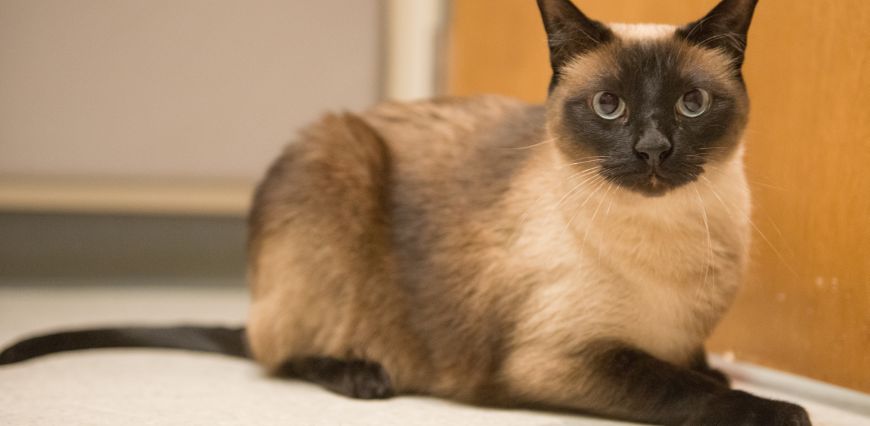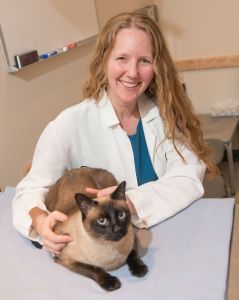
Colorado State University is the sole veterinary institution in the nation using stem-cell therapy to treat feline kidney disease, which is common among pet cats, and researchers are now launching a new clinical trial to further explore the power of stem cells to improve organ function.
“It’s something that more cats will have to deal with over any other disease, and we don’t know enough about it,” said Dr. Jessica Quimby, the CSU veterinarian leading the trial. “We have so much to do from a scientific standpoint. We want to study all potential therapies and help these cats live comfortably.”
Chronic kidney disease is common in older cats. Yet other than a kidney transplant, there is no cure, and risk factors for the disease are poorly understood.
For the new clinical trial, Quimby and her colleagues seek cat patients with stable, stage 4 chronic kidney disease, also known as renal disease. Cats with concurrent diseases are not eligible. For more information and to enroll, visit the clinical trial webpage.
As is the case in human medical trials, clinical trials for animals give chronically and acutely ill patients additional treatment options using therapies that are under development. The approach is designed to provide medical help for enrolled patients, while also gathering data that advances knowledge and solutions.
Study suggests promise, offers hope to pets and people

In previous clinical trials, a few cats with more advanced stages of disease showed little disease progression years after treatment. The findings of those studies encouraged CSU researchers to launch a new one focusing on later stages of the disease.
“Up until now, we’ve focused on cats with early stages of the disease with the hope of slowing disease progression,” Quimby said. “We noticed that a few cats with worse stages in those studies were actually doing really well. We can’t ignore the possibility that stem cells could help those cats, too.”
The research could have a translational impact in human medicine. Though the diseases may start for different reasons, human kidney disease progresses in a similar manner to its feline counterpart, Quimby said.
“Kidney disease is indeed a huge and growing problem in human medicine,” Quimby said. “If we saw improvement with cats, we could relate it to curing humans.”
Stem cells cannot repair the irreversible kidney scarring prominent in later stages of the disease. But CSU researchers hope stem cells will improve overall kidney function, even when the organs are damaged.
Shelley McCarron enrolled her cat, Baxter, a 6-year-old Siamese, in a CSU stem-cell study a year ago and has seen benefit.
“I believe the treatments have stabilized his kidneys rather than restoring them, but we’re grateful nonetheless,” McCarron said. “It’s certainly better to be stabilized than continue to decline.”
Watch Dr. Quimby discuss the study in this CBS Denver video.

Stem cells are anti-inflammatory and promote vascular health, improving blood flow, Quimby explained. The cells are harvested from the fat of healthy donor cats, which are not harmed by the collection.
Patients in the new clinical trial will receive three stem-cell injections, each two weeks apart. Veterinarians will run a variety of diagnostic tests before, during and after treatment to determine the effect of the treatments.
Many costs for participation in the clinical trial are covered through Frankie’s Fund for Feline Stem Cell Research – a fund named for a Seal Point Siamese cat that helped CSU researchers to pioneer stem-cell treatment for chronic kidney disease in 2009.
Frankie’s photo hangs in Quimby’s office at the James L. Voss Veterinary Teaching Hospital, a reminder of the promise stem-cell therapy has shown in treating one of the most puzzling feline diseases.
“As kidney disease progresses, cats don’t eat well and begin to feel pretty sick. It’s hard for owners to see their cats in that state,” Quimby said. “I want so much to be able to help their beloved pets.”
To donate to the fund or other funds to support veterinary work in chronic kidney disease, including Buttons duh Cat Legacy Fund, visit the Frankie’s Fund webpage.
Chronic kidney disease in cats
Could your cat have chronic kidney disease? The disease occurs when kidneys do not fully remove waste products from the blood and toxicity builds up. Signs include:
- Abnormal weight loss
- Poor appetite
- Lethargy
- Increased thirst
- Increased urination
- Vomiting
- Poor coat
- Bad breath